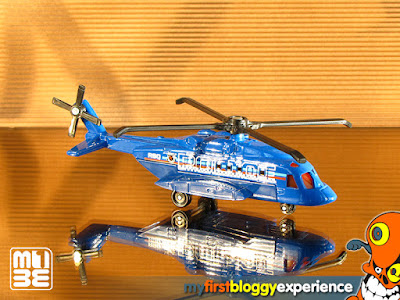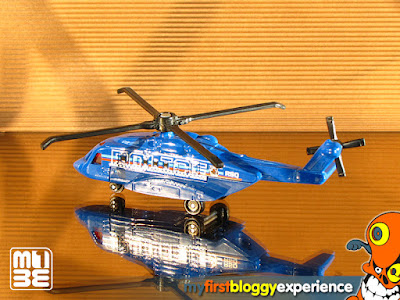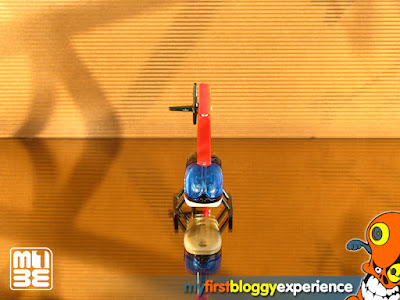For English version scroll below
Entre los varios tipos de aeronaves en existencia, hay una que sigue siendo para mí el más fascinante de todos y es el helicóptero, en su variedad de formas y usos; creo que hay buenas razones para mi preferencia por esa clase de vehículo aéreo...
El concepto en sí de helicóptero, el cual tiene un enfoque sustancialmente diferente a la idea de volar planteada por el avión "convencional" es algo bastante interesante: quiero decir, mientras un avión es una aeronave planeada y desarrollada para vuelo horizontal, un helicóptero es capaz de ofrecer vuelo multidireccional (vertical, horizontal, lateral, hacia adelante, hacia atrás o permanecer estacionario en el aire)....
En otras palabras, los helicópteros ofrecen una forma más "natural" o al menos una más versátil y práctica de volar, que sus contrapartes en la forma de aviones y el único equivalente de este último tipo de aeronaves es el Harrier, un caza / bombardero, jet de salto de un solo motor, desarrollado por Hawker Siddeley Aviation, una compañía británica.
Ahora, esta versatilidad para volar se hizo realidad gracias a una ingeniería mucho más compleja para la estructura, poder y control de estas aeronaves, que la ingeniería usada en los aviones: los helicópteros usan básicamente una o más hélices o rotores horizontales motorizados, y uno o más rotores verticales en la cola, con el fin de lograr esta proeza del vuelo multidireccional.
La complejidad en la ingeniería fue reflejada en un tiempo mayor de desarrollo para los helicópteros, que para los aviones; mientras que el primer avión funcional fue probado por los hermanos Wright en 1903, el primer helicóptero funcional fue probado por Igor Sikorsky en 1939.
Para esta publicación estoy introduciendo un par de invitados que representan helicópteros con características diferentes: el Sikorsky S-92 de 2004, un Helicóptero de Doble Motor, de Tamaño Mediano, Elevación Media, Multi-Rol Utilitario / Transportador para Operaciones Civiles, de Sikorsky Aircraft y el Robinson R44 Raven I de 1993, un Helicóptero Compacto Liviano, de un Solo Motor, 4 Plazas, Elevación Media para Operaciones Civiles, de Robinson Helicopter Company.
Ambos ejemplos muestran cuán versátil puede ser un helicóptero cuando se trata de transporte por aire, ya sea que estemos hablando de pasajeros, carga o una combinación, uno de ellos es un aparato grande, mientras el otro es más bien pequeño, pero ambos son usados básicamente para transporte de personas, como vehículos civiles o militares.
El Sikorsky S-92 tuvo su primer vuelo de prueba en 1998, fue desarrollado a partir del Sikorsky S-70, es usado primariamente para transporte de pasajeros y material costa afuera a plataformas de petróleo o gas, también para trabajos de búsqueda y rescate, tiene capacidad para 2 miembros de tripulación y hasta 19 pasajeros, con un rango de 999 km.
El Robinson R44 de 1993, por otro lado, tuvo su primer vuelo de prueba en 1990, fue desarrollado a partir del Robinson R22, un helicóptero de 2 plazas, es un transporte de pasajeros multipropósito, también usado como entrenador para vuelo en helicóptero, tiene capacidad para 1 miembro de tripulación y 3 pasajeros, con un rango de 643 km...
Para esta reseña, conseguí un ejemplo de cada helicóptero en la forma de vehículos de juguete, a través del mercado primario, en una tienda miniorista local, hace más o menos 6 años; son parte de un box-set, una versión especial del 5-pack, pertenecen a la Serie Matchbox On a Mission / Mission Force: Police de 2014 y puedes leer sobre el otro helicóptero de Majorette presentado en esta sesión de fotos aquí...
A diferencia de los 5-packs convencionales, estos box-sets incluyen, junto con modelos de Series de la categoría Regular (Línea Principal) de Matchbox, otros modelos de la línea Skybusters (aviones, helicópteros y otras aeronaves) y/o de la línea Real Working Rigs line (tanques, camiones, tractores y otra clase de vehículos para trabajo pesado), los cuales usualmente presentan partes deslizables / móviles y son más grandes que las contrapartes de la Línea Principal...
Por lo tanto, la presentación para esta línea difiere de aquella de los 5-packs convencionales: es una caja con ventana horizontal, en lugar de la caja con ventana vertical de estos últimos.
La línea Mission Force fue introducida por Matchbox en 2012 y descontinuada en 2015, la razón para eso no fue precisamente la carencia de éxito de la línea, sino más bien su buena relación calidad-precio: sí, lo oiste bien, fue descontinuada porque hizo que Mattel perdiera algo de ganancias y el gigante rojo tiende a ser "algo" avaro, si me lo preguntas...
Ambos helicópteros de juguete ofrecen fuselaje en diecast y base plástica, en azul y negro respectivamente, pero la dosis de diecast en cada caso es diferente: el Sikorsky S-92 está en el filo de ser considerado un plastcast, porque parte del fuselaje fue hecho también en plástico y el Robinson R44 es definitivamente un plastcast, lo cual es una lástima, porque tiene mejores detalles generales en los moldes que el Sikorsky.
Las hélices o aspas para ambos helicópteros fueron hechas en plástico, negro y rojo respectivamente; el trabajo de pintura para el Sikorsky fue hecho en azul rey con acabado brillante, complementado por tampos en blanco, azul claro, rojo y negro, sobre los paneles laterales, mientras el trabajo de pintura para el Robinson fue hecho en negro con acabado brillante, complementado por tampos en blanco, azul claro y rojo, sobre los paneles laterales.
El Sikorsky no tiene interiores, mientras estos fueron trabajados en negro para el Robinson, con un nivel de detalle básico, las ventanas son tintadas en rojo y azul respectivamente; las ruedas plásticas para el Sikorsky presentan diseño Mini Skybusters en negro, mientras el Robinson presenta patines de aterrizaje y ambos fueron hechos en Tailandia...
Ezq 34:6-10 "Y anduvieron perdidas mis ovejas por todos los montes, y en todo collado alto: y en toda la haz de la tierra fueron derramadas mis ovejas, y no hubo quien buscase, ni quien requiriese. Por tanto, pastores, oid palabra de JEHOVÁ: Vivo yo, ha dicho el SEÑOR JEHOVÁ, que por cuanto mi rebaño fué para ser robado, y mis ovejas fueron para ser comidas de toda bestia del campo, sin pastor; ni mis pastores buscaron mis ovejas, sino que los pastores se apacentaron á sí mismos, y no apacentaron mis ovejas; por tanto, oh pastores, oid palabra de JEHOVÁ: Así ha dicho el SEÑOR JEHOVÁ: He aquí, yo á los pastores; y requeriré mis ovejas de su mano, y haréles dejar de apacentar las ovejas: ni los pastores se apacentarán más á sí mismos; pues yo libraré mis ovejas de sus bocas, y no les serán más por comida."
English version
Among the several types of aircrafts in existence, there is one that remains for me the most fascinating of all and it’s the helicopter, in its variety of forms and uses; I think there are good reasons for my preference for that kind of aerial vehicle...
The concept itself of helicopter, which had a substantially different approach to the idea of flying posed by the "conventional" airplane, is something quite interesting: I mean, while an airplane is an aircraft planned and developed for horizontal flight, a helicopter is able to offer multidirectional flight (vertical, horizontal, lateral, forward, backward or remaining stationary in the air)...
In other words, helicopters offer a more "natural" or at least a more versatile and practical way of flying, than their counterparts in the form of airplanes and the only equivalent of the latter type of aircraft is the Harrier, a single-engine jump-jet fighter / bomber, developed by Hawker Siddeley Aviation, a British company.
Now, this versatility for flying came true thanks to a way more complex engineering for the structure, power and control of these aircraft, than the engineering used in airplanes: helicopters use basically one or more horizontal powered propellers or rotors, and one or more vertical rotors in the tail, in order to achieve this prowess of multidirectional flight.
The complexity in the engineering was reflected in a longer time of development for helicopters than for airplanes, while the first functional airplane was tested by the Wright brothers in 1903, the first functional helicopter was tested by Igor Sikorsky in 1939.
For this publication I’m introducing a pair of guests that represent helicopters with different characteristics: the 2004 Sikorsky S-92, a Twin-Engined Midsize Medium-Lift Multi-Role Utility / Transport Helicopter for Civil Operations, by Sikorsky Aircraft and the 1993 Robinson R44 Raven I, a Compact Single-Engined 4-Seat Medium-Lift Light Passengers Helicopter for Civil Operations, by Robinson Helicopter Company.
Both examples show how versatile can be a helicopter when it comes to transportation by air, whether we are talking about passengers, cargo or a combination, one of them is a big apparatus, while the other is rather small, but both are basically used for people transportation, as civilian or military vehicles.
The Sikorsky S-92 had its first test flight in 1998, it was developed from the Sikorsky S-70, it’s used primarily for offshore transportation of passengers and material to oil and gas rigs, also for search and rescue duties, it has capacity for 2 crew members and up to 19 passengers, with a range of 999 km.
The 1993 Robinson R44, on the other hand, had its first test flight in 1990, it was developed from the Robinson R22, a 2-seater helicopter, it’s a multipurpose passengers transportation, also used as trainer for helicopter flight, it has capacity for 1 crew member and 3 passengers, with a range of 643 km...
For this review, I got a sample of each helicopter in the form of toy vehicles, through the primary market, in a local retail store, pretty much 6 years ago; they are part of a box-set, a special version of the 5-pack, they belong to the 2014 Matchbox On a Mission / Mission Force: Police Series and you can read about the other helicopter by Majorette featured in this photoshoot here...
Unlike the conventional 5-packs, these box-sets include, along with models from Series of the Regular category (Mainline) of Matchbox, other models from the Skybusters line (airplanes, helicopters and other aircraft) and/or from the Real Working Rigs line (tanks, trucks, tractors and other kind of heavy duty vehicles), which usually feature moving / sliding parts and are larger that their Mainline counterparts...
Hence, the presentation for this line differs from that of the conventional 5-packs: it’s a bigger horizontal window box, instead of the vertical window box of the latter.
The Mission Force line was introduced by Matchbox in 2012 and discontinued in 2015, the reason for that was not precisely the lack of success of the line, but rather its good value for money: yeah, you heard that right, it was discontinued because it made Mattel lose some profit and the red giant tends to be "somewhat" greedy, if you ask me...
Both toy helicopters offer diecast fuselage and plastic base, in blue and black respectively, but the dose of diecast in each case is different: the Sikorsky S-92 is in the edge of being considered a plastcast, because part of the fuselage was made also in plastic and the Robinson R44 is definitely a plastcast, which is a pity, because it has better overall details in the molds than the Sikorsky.
The propellers or blades for both helicopters were made in plastic, black and red respectively; the paint job for the Sikorsky was made in royal blue with glossy finishing, complemented by tampos in white, light blue, red and black, on the side panels, while the paint job for the Robinson was made in black with glossy finishing, complemented by tampos in white, light blue, red, on the side panels.
The Sikorsky has no interiors, while these were worked in black for the Robinson, with a basic level of detail, the windows are red and blue tinted respectively; the plastic wheels for the Sikorsky feature Mini Skybusters design in black, while the Robinson features landing skids and both were made in Thailand...
Ezk 34:6-10 "My sheep wandered through all the mountains, and upon every high hill: yea, my flock was scattered upon all the face of the earth, and none did search or seek after them. Therefore, ye shepherds, hear the word of the LORD; As I live, saith the Lord GOD, surely because my flock became a prey, and my flock became meat to every beast of the field, because there was no shepherd, neither did my shepherds search for my flock, but the shepherds fed themselves, and fed not my flock; Therefore, O ye shepherds, hear the word of the LORD; Thus saith the Lord GOD; Behold, I am against the shepherds; and I will require my flock at their hand, and cause them to cease from feeding the flock; neither shall the shepherds feed themselves any more; for I will deliver my flock from their mouth, that they may not be meat for them."



























.jpg)






















No comments:
Post a Comment